🧱 Ultimate Guide to the Jenga Game: How to Play, Rules & Tower-Building Tips
Published: April 2025 | Author: Damian Smith
- Jenga Rules Explained Clearly
- How to Play Jenga: A Step-by-Step Guide
- Creative Jenga Variants & Challenges
- Where to Buy Jenga & Recognizing Authentic Products
- FAQs About Jenga
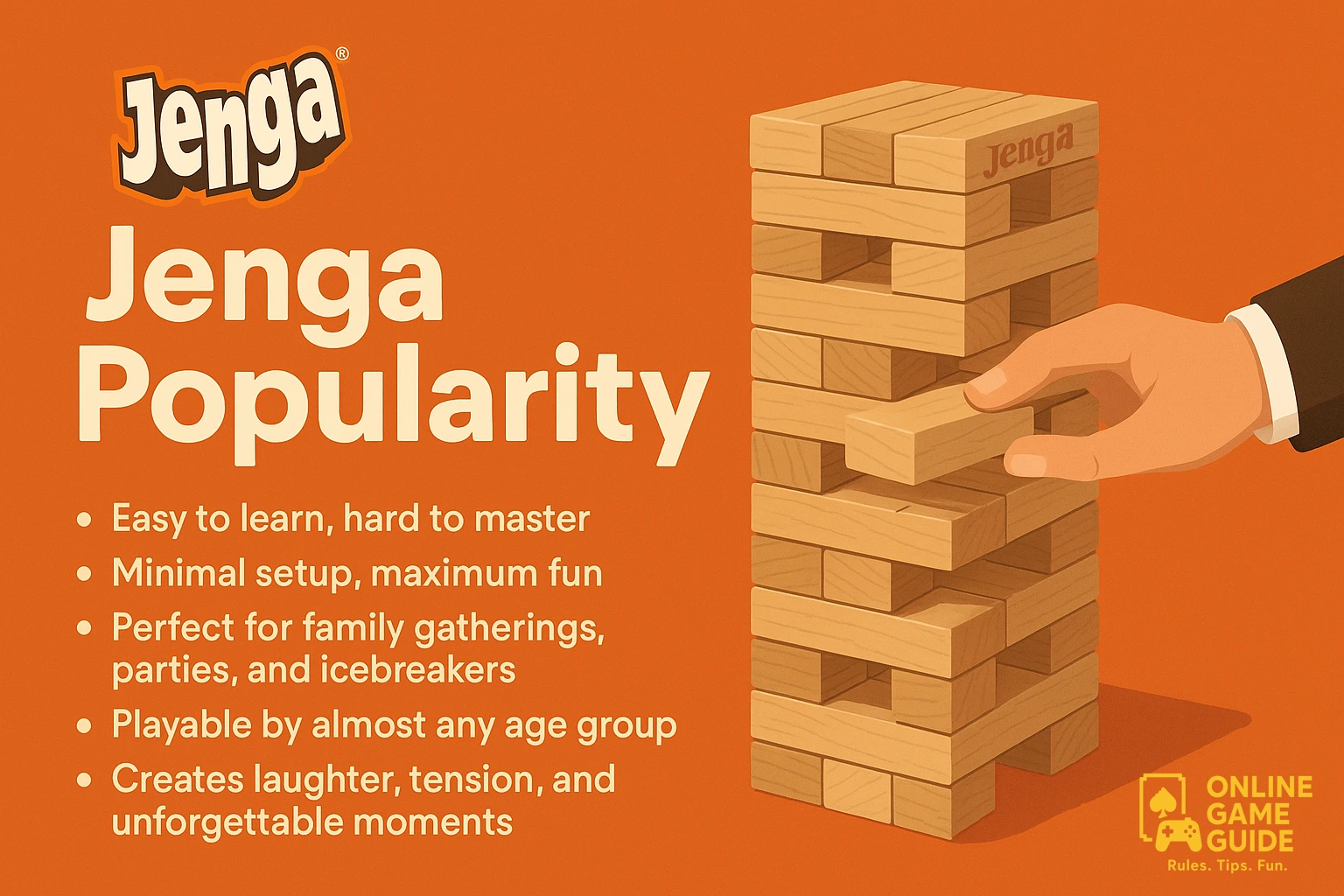
Brief History of the Jenga Game
The Jenga game was born from a blend of balance, suspense, and a little bit of chaos. It was created by Leslie Scott, a British board game designer who drew inspiration from wooden stacking games she played in her youth in Ghana. The game was officially launched in the early 1980s and has since become a staple in households, bars, and even classrooms around the world.
Why Jenga Became a Classic
Few games manage to combine simplicity with such intense fun. What makes Jenga a timeless hit is its accessibility. Whether you're 6 or 60, anyone can play — no elaborate rulebook, no steep learning curve, just good old-fashioned suspense and a steady hand. Over the decades, the game has seen spin-offs, giant editions, and even branded licensing deals, yet the core experience remains refreshingly unchanged.
Key Reasons for Jenga's Enduring Popularity:
- Easy to learn, hard to master
- Minimal setup, maximum fun
- Perfect for family gatherings, parties, and icebreakers
- Playable by almost any age group
- Creates laughter, tension, and unforgettable moments
Jenga Rules Explained Clearly
Why Rules Matter in Jenga
While Jenga is often pulled off a shelf as a casual party game, don’t let the minimal setup fool you. The rules of Jenga are what transform it from a simple block stacker into a test of nerves, balance, and tactical thinking. Whether you’re playing at home, in a tournament, or at a team-building event, understanding the proper Jenga rules ensures the game stays fair — and full of tension.

The Official Jenga Rules (Hasbro Standard)
Here’s what Hasbro — the current distributor of the Jenga brand — defines as the official rules of Jenga. These rules apply to the classic version of the game, typically played with 54 uniform hardwood blocks.
Core Gameplay Rules:
- Players: 2 or more
- Objective: Remove one block from the tower and place it on top without making the tower fall
- Start: Build a tower of 18 layers with 3 blocks per layer, alternating direction at each level
Turn-by-Turn Rules:
- Only one block may be removed per turn.
- You must use only one hand to touch or remove a block.
- You may touch multiple blocks to test for looseness — but once a block is moved, that’s your choice.
- After placing the block on top, the turn ends once the next player touches the tower or 10 seconds pass.
- The game ends when the tower falls. The last player to successfully place a block wins.
Important Clarifications:
- Players may not skip turns.
- You must place the removed block on top before the next player begins.
- The tower must always maintain its stacked structure — no placing blocks sideways or diagonally on top.
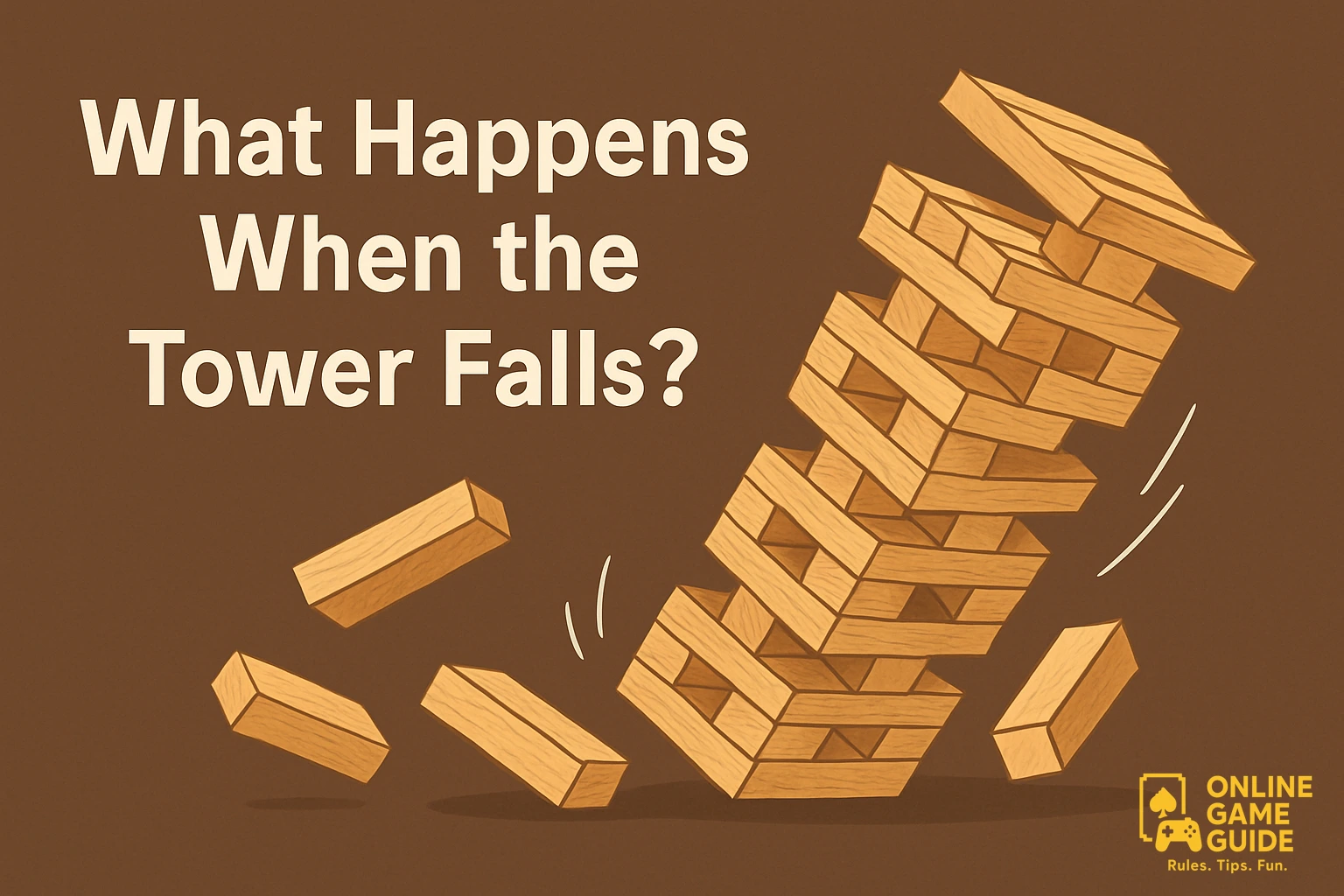
What Happens When the Tower Falls?
When the tower collapses, it's game over. If it happens during your turn — whether you're placing a block or testing one — you’re the one who takes the loss. This is the moment that usually triggers cheers, laughter, and a swift “Let’s play again!”
How to Handle a Collapse:
- The responsible player loses. Simple and non-negotiable.
- Reset the tower and start a new game — or switch up the rules for a fresh challenge.
- Optional: Give a fun penalty — a silly dare, a trivia question, or a mini challenge.
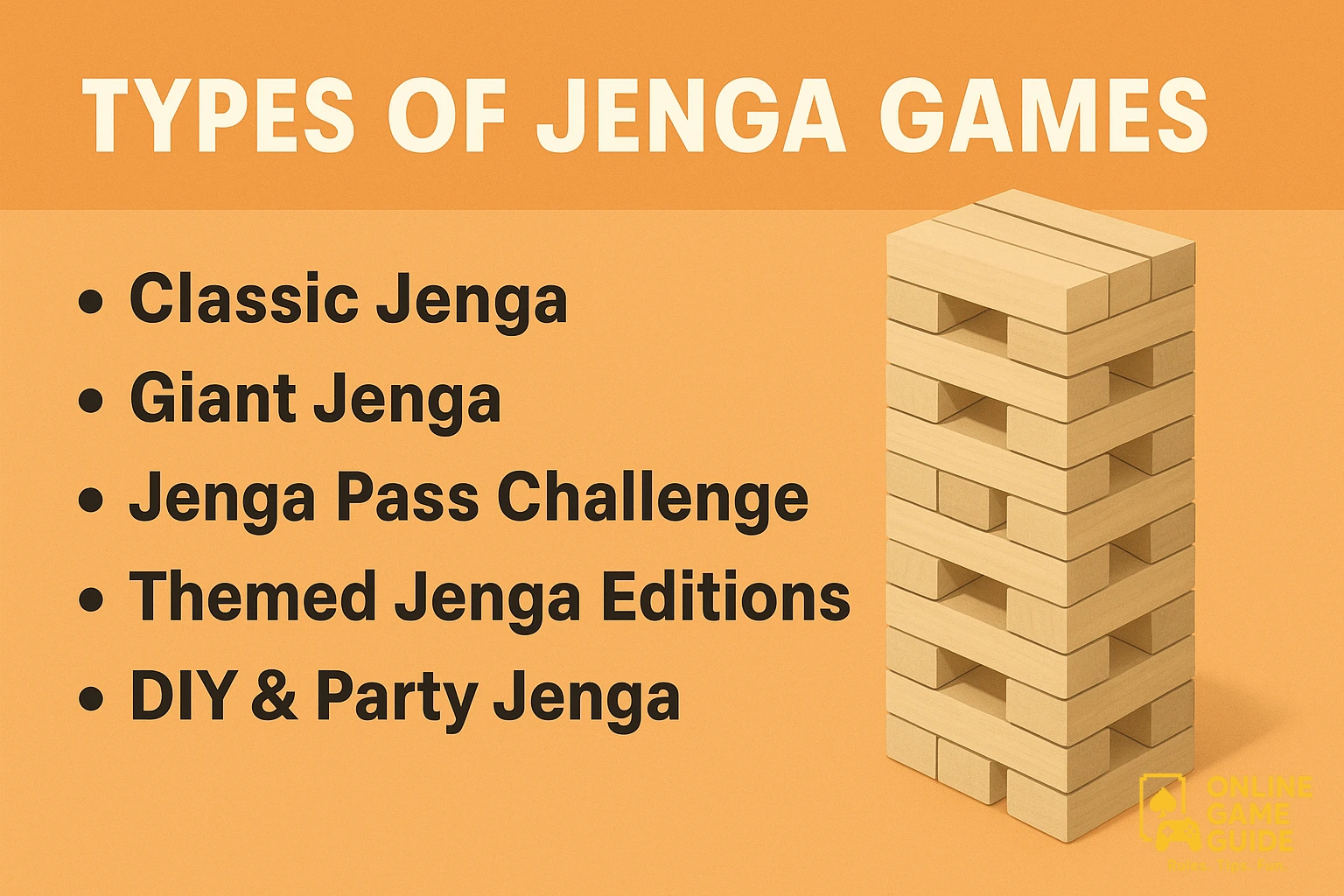
Types of Jenga Games You Can Play
Popular Variants of Jenga Games:
- Classic Jenga – The original and most widely played version.
- Giant Jenga – Oversized blocks perfect for outdoor events and parties.
- Jenga Pass Challenge – Play on a handheld platform for added chaos.
- Themed Jenga Editions – Featuring designs inspired by franchises like Harry Potter, Super Mario, and more.
- DIY & Party Jenga – Blocks customized with questions, dares, or trivia for game night fun.
Did You Know?
Some giant Jenga games can reach over five feet tall before falling — turning a simple game into a towering spectacle.
From understanding the materials behind Jenga blocks, to mastering the setup of a Jenga tower, to exploring creative versions of Jenga games, it’s clear this classic has more depth than meets the eye. One thing’s certain: the higher the tower, the harder the fall.
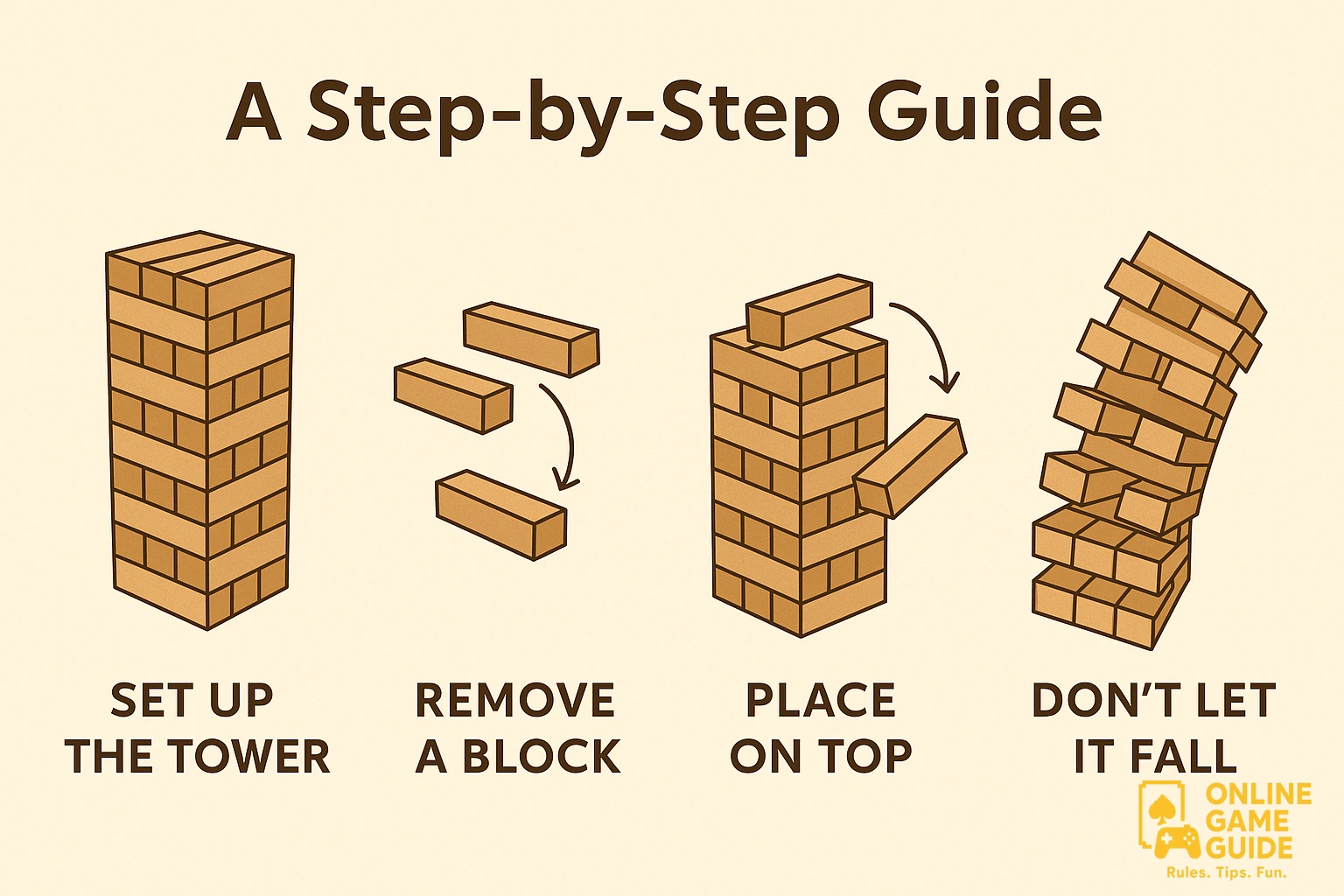
How to Play Jenga: A Step-by-Step Guide
How Many Blocks Are in a Jenga Set?
Every classic Jenga set includes exactly 54 wooden blocks. Each block is precisely cut to ensure uniform size and weight, which is essential for the game’s delicate balance. With these 54 pieces, players construct a tower that challenges both skill and strategy.
Jenga from Setup to Collapse
If you're wondering how to play Jenga, it's refreshingly simple in concept—but surprisingly intense in execution. The game begins with a careful setup and ends, often loudly, with a dramatic tumble.
Setting Up the Jenga Tower
- Start by placing three blocks side by side to form a single row.
- Stack another row of three on top, rotated 90 degrees from the one below.
- Keep stacking until you've built 18 layers with all 54 blocks — your tower is now ready for action.
- Ensure the surface is flat and stable—wobbles are for gameplay, not setup.
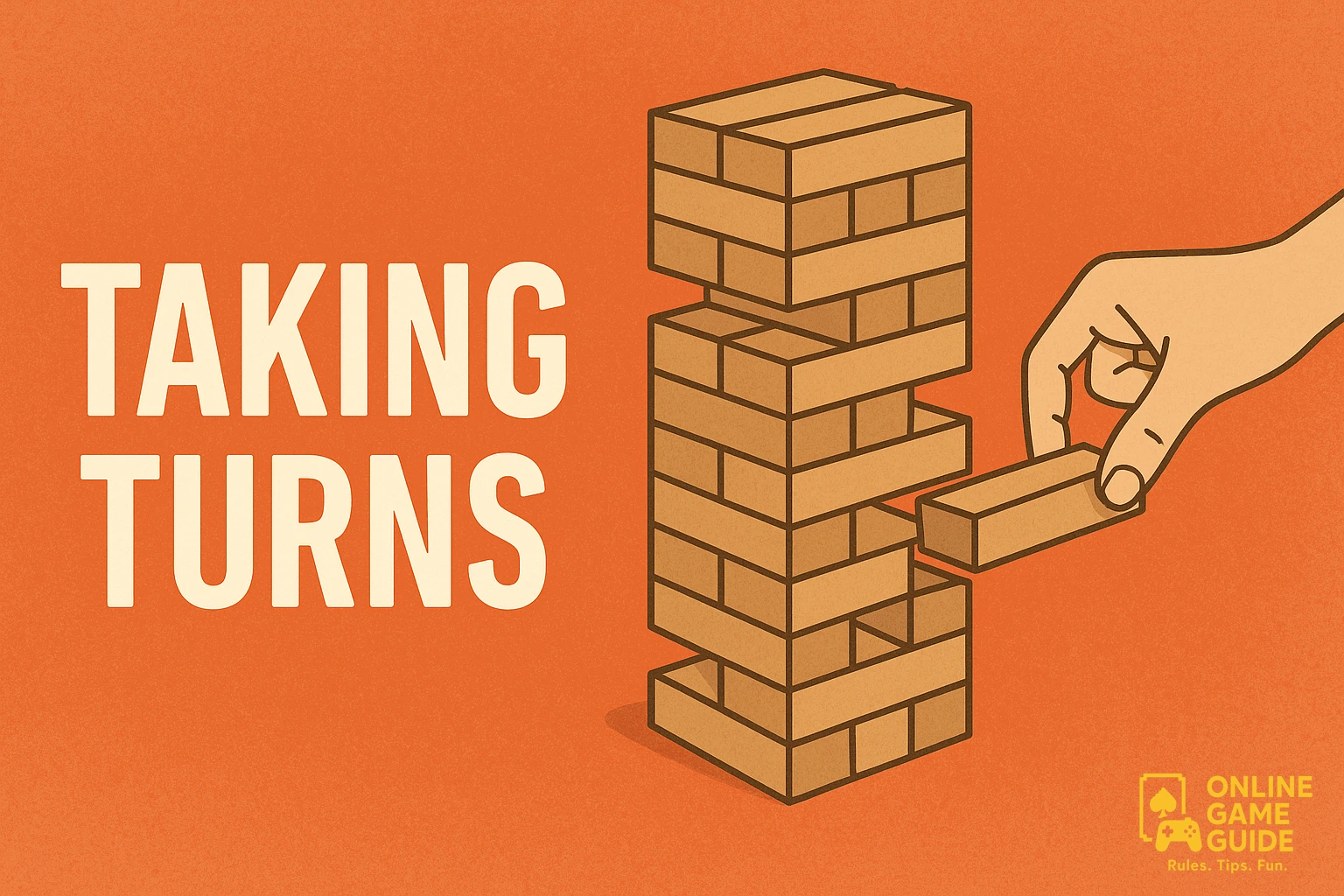
Taking Turns
Players take turns removing one block at a time from any layer below the topmost completed row. The removed block must then be placed on the very top of the tower, maintaining the alternating pattern. The game continues until the tower falls.
Important Rule:
Pro Tips for Pulling and Stacking
Now that you know how to play Jenga, let’s talk finesse. What separates a beginner from a seasoned pro? It's all in the way you handle those blocks.
Block Pulling Techniques:
- The Gentle Wiggle: Gently nudge blocks side to side to test for looseness before committing.
- Low Risk First: Target blocks in the middle of the tower or near the top—avoid the structural cornerstones early on.
- Speed Kills: Be smooth, not fast. Rushing increases the chance of a collapse.

Strategies to Keep the Jenga Tower Standing
Mastering Jenga building isn’t just about surviving your turn—it’s about setting traps for your opponents while maintaining the tower’s integrity.
Advanced Tactics for Stability:
- Center Your Weight: Try to keep blocks toward the middle when placing them on top.
- Build a Balanced Top: Don’t stack blocks all to one side—an uneven top makes every following move harder.
- Watch Your Opponents: Learn from their mistakes and avoid risky moves they barely survived.
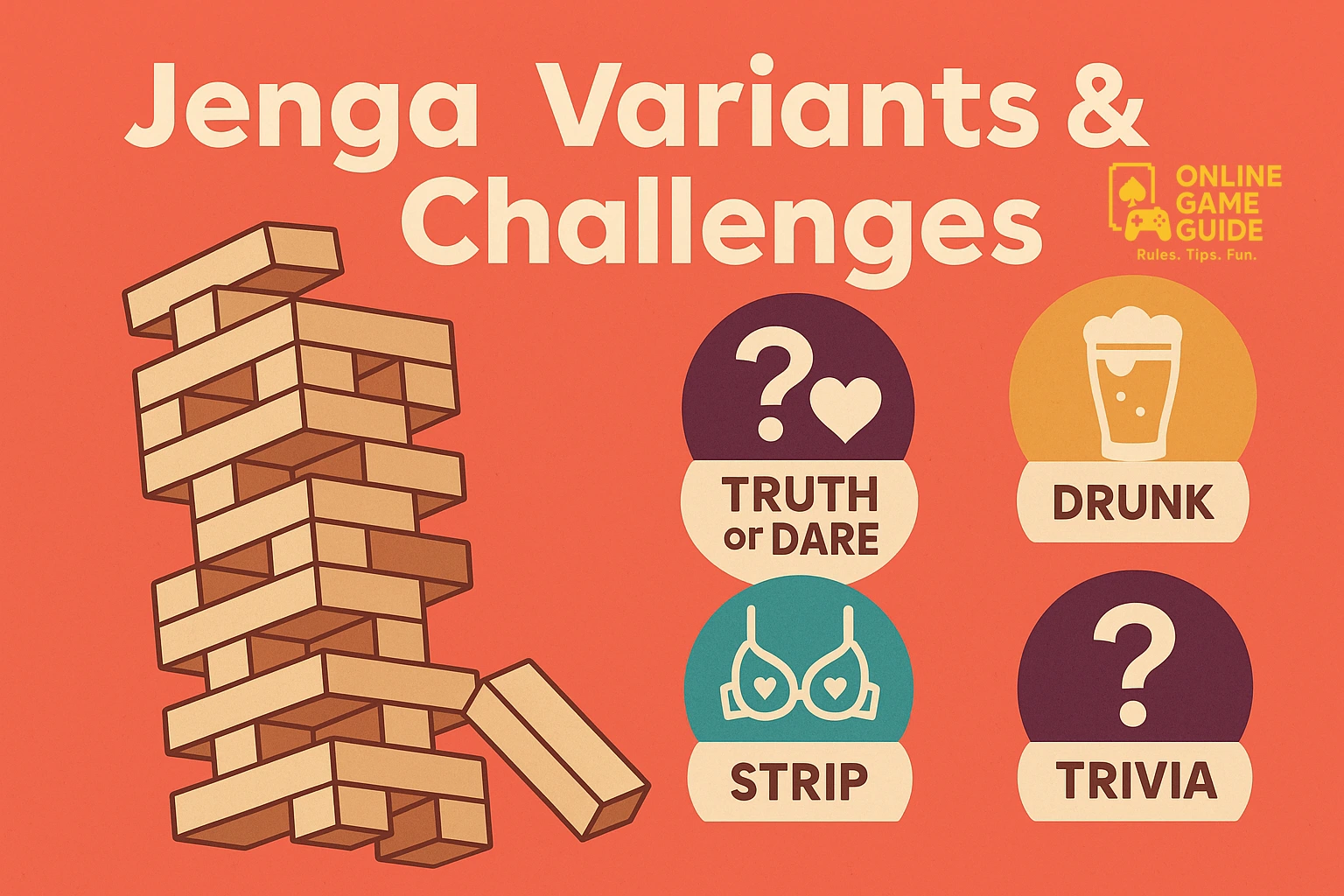
Creative Jenga Variants & Challenges
Turning the Classic Jenga Game into a Party Hit
The original Jenga game is great on its own—but with a few twists, it becomes the ultimate crowd-pleaser. Whether you’re hosting a party, organizing a game night, or just looking to spice things up, there’s a Jenga variant for the occasion. These custom versions blend the tension of Jenga building with creative rules, challenges, and consequences that bring a whole new layer of fun.
Popular Jenga Variants for Parties:
- Truth-or-Dare Jenga: Each block has a challenge written on it. Pull a block, do what it says.
- Drunk Jenga: A classic with an adult twist—assign shots, rules, or penalties to different blocks.
- Strip Jenga: For grown-up game nights. You pull a block, you lose a layer (of clothing or pride).
- Trivia Jenga: Answer a trivia question after every pull—or face a silly punishment.
- Couples Jenga: Add questions or dares to blocks focused on relationships and bonding.

Pro Tip:
Use a permanent marker or colored stickers to label each block. That way, you can personalize the experience while keeping the game structure intact.
Jenga for Team-Building & Learning Activities
Jenga isn't just for fun and games — it’s also an excellent tool for education and professional development. Many teachers, counselors, and team leaders now use Jenga games as interactive exercises that promote communication, critical thinking, and collaboration.
How to Use Jenga in Structured Environments:
- Classroom Jenga: Each block includes a review question or vocabulary word. Pull it, answer it, stack it.
- Team-building Jenga: Add reflective or icebreaker questions to each block to spark conversation.
- Therapeutic Jenga: Counselors write prompts on each block to encourage emotional discussion.
Why It Works:
Because the gameplay is simple and familiar, it helps people relax. The pressure is on the tower, not the participants — which opens the door for honest interaction and organic problem-solving.

Going Digital: Jenga in the Online World
The digital age hasn’t left the Jenga building experience behind. There are now multiple virtual versions of the Jenga game that let you test your skills solo or with friends across the globe. Perfect for remote game nights or casual stress relief at your desk.
Popular Online & App-Based Jenga Games:
- Jenga AR/VR: Some mobile apps use augmented reality to simulate real-life tower-building.
- Browser-Based Jenga: Basic 3D versions you can play on desktop or mobile with multiplayer support.
- Gamified Jenga Apps: Mobile games that mix Jenga-style physics with puzzles or objectives.
Bonus:
Digital Jenga may not have the satisfying *clack* of falling wooden blocks, but it still delivers the tension and strategy fans love—with the added bonus of zero cleanup.
From hilarious house rules to meaningful group activities, and even online adaptations, the possibilities with Jenga games are endless. All it takes is a little imagination to transform your standard Jenga building session into something unforgettable.
Where to Buy Jenga & Recognizing Authentic Products
How to Spot the Original Jenga Logo and Genuine Sets
With countless imitations flooding the market, knowing how to recognize an authentic Jenga set is more important than ever. The true game is produced by Hasbro (formerly under Milton Bradley), and features the distinctive Jenga logo — bold, stacked lettering often in orange or yellow tones, designed to evoke the game's iconic tower shape.
Signs of a Genuine Jenga Product:
- Look for the official Jenga logo with a registered trademark (®) symbol.
- Packaging should mention Hasbro, Hasbro Gaming, or Pokonobe Associates (the game's original licensing company).
- The blocks are uniformly cut and sanded for a smooth finish—no splinters or irregular edges.
- Includes exactly 54 blocks made from real hardwood, not soft or composite materials.
Watch Out for These Red Flags:
Misspelled brand names, poor packaging design, or sets with uneven, lightweight blocks are likely counterfeits. If you spot a deal that looks unbelievably cheap, there’s a good chance it’s not the real thing.
Popular Retailers and Online Shops
To ensure you're purchasing a legitimate set, it’s best to buy from trusted retailers. Authentic Jenga sets are widely available through reputable toy stores and trusted online retailers.
Trusted Sources to Buy Jenga:
- On Amazon, stick to listings sold directly by Amazon or the official Hasbro storefront to avoid knockoffs.
- Walmart – Carries multiple versions, including Classic and Giant Jenga.
- Target – Offers themed editions and party variants.
- Hasbro.com– The official source for brand-new, limited edition, or collectible Jenga sets.
- Local toy stores – Great for checking quality in person and supporting small businesses.
Pro Tip:
Avoid listings without clear branding or seller information. Before you click “Buy,” take a moment to read customer reviews and make sure the return policy has your back—just in case.
Authentic vs. Knockoff: What to Look For
- Material: Real Jenga uses smooth, dense hardwood. Fakes often use soft, flimsy wood or plastic.
- Size Consistency: Genuine blocks are laser-cut for accuracy. Knockoffs tend to vary in width or thickness, ruining the gameplay experience.
- Finish: Real blocks are evenly sanded; fake ones may feel rough or splinter easily.
Why It Matters
Poor-quality sets not only ruin the tension and challenge of a proper game, but can also be unsafe—especially for kids. A high-quality set ensures the right weight distribution, balance, and longevity you expect from the real Jenga game.
When it comes to buying Jenga, always aim for the real deal. That way, you’re not just stacking blocks — you’re building memories, one wobble at a time.
Why Stability Matters
As players remove blocks from lower layers and place them on top, the Jenga tower shifts. Its center of gravity changes, increasing instability. Every turn heightens the tension, building toward that dramatic collapse everyone’s anticipating.
The Jenga Logo: A Fun Bit of Branding Trivia
The iconic Jenga logo has seen minor tweaks over the years, but its bold, blocky aesthetic has always reflected the game's physical nature. A lesser-known fact? The name “Jenga” comes from the Swahili word kujenga, which means "to build." That’s not just branding — that’s linguistic genius, rooted in the game’s very DNA.